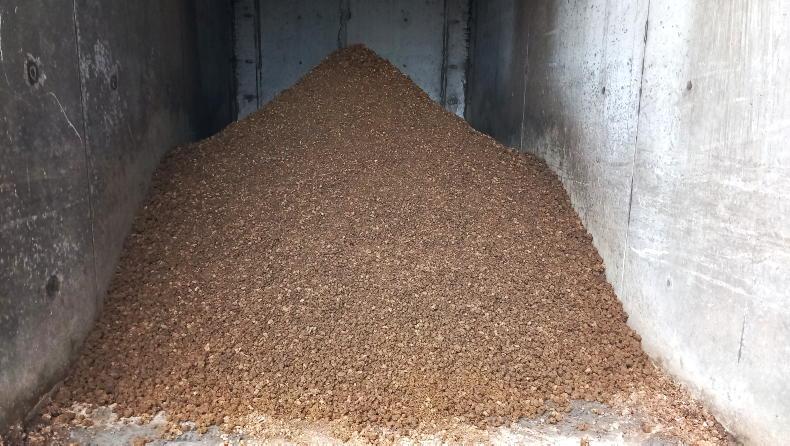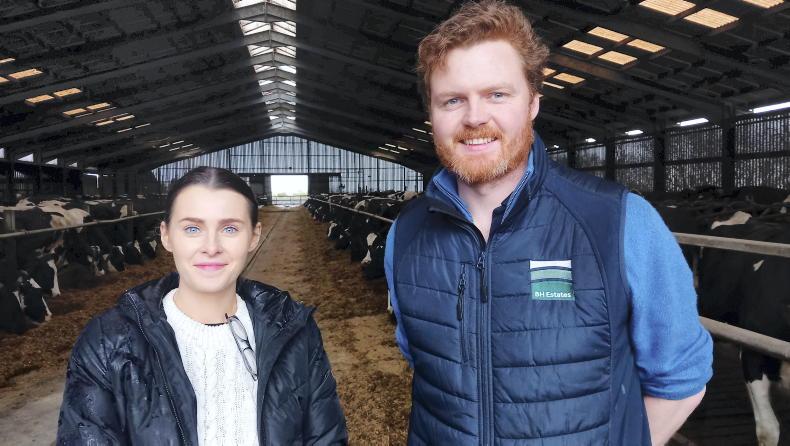A screw press slurry separator is being used on a dairy unit in Co Down as part of ongoing research into making better use of phosphorus from local farms.
Surplus phosphorus from agriculture has been a long-running issue for water quality in NI and it was a contributing factor behind the algal blooms in Lough Neagh last year.
In 2017, the dairy unit at Blakiston Houston (BH) Estates in Dundonald installed a screw press system which effectively separates slurry into solid and liquid fractions.
Jack Blakiston Houston, director of BH Estates, said the separator can free up 20% extra slurry storage when the solid fraction is removed from raw slurry.
The liquid fraction, which goes back into slurry tanks, is also easier to mix and apply to land, especially with low emission slurry spreading equipment.
“We initially installed the screw press to make slurry management easier and to free up space in tanks so we could have better timing of slurry applications,” Jack said.
In 2023, BH Estates was one of six companies in NI to receive a £100,000 grant through a DAERA-led initiative to investigate sustainable nutrient use on local farms.
Speaking to the NI Institute of Agricultural Science last week, Jack explained that a higher concentration of phosphorus ends up in the solid fraction after slurry has been through a screw press.
He presented figures from the project which found raw slurry contained 0.5kg of phosphorus per tonne, whereas the solid fraction after separation contained 1kg per tonne.
AD plant
BH Estates also has a 500kW anaerobic digestion (AD) plant where the solid fraction from separated slurry can be used as a feedstuff.
Jack said one tonne of slurry solids produces around 75% of the biogas that one tonne of grass silage will yield.
Nutrients are concentrated further in the AD process and, after digestate from the AD plant has been through screw press separation, the project found it contained 1.87kg of phosphorus per tonne.
To be clear, the slurry separator and AD plant do not remove phosphorus, so if there is excess phosphorus on a farm or AD plant, the problem will still exist.
However, Jack points out that the key benefit is that the two processes concentrate phosphorus. This can make it easier to transport and re-distribute nutrients to where there is shortage, with renewable energy produced in the process.
As part of the BH Estates project, slurry from eight other farms was separated and the liquid fraction stayed on the original farms.
The solid fractions, which came to 700t in total, were transported to BH Estates and used in the AD plant.
According to Jack, the feedback from the farmers involved in the project has been positive, mainly because the liquid fraction of the slurry
was easier to store, mix and apply.
“At the minute, we can use the digestate on our arable land, but our phosphorus indexes [from soil analyses] are slowly building, so in the long term we need to look at digestate processing and export,” he said.
Biofertiliser model
Jack suggests a “biofertiliser plant” could be a key solution. The model is based around slurry being separated on farms by mobile screw press units, with the solid fraction utilised by a series of AD plants.
The digestate from these AD plants could then be processed in a plant to produce biofertiliser which is exported out of NI to areas where soils are low in phosphorus.
Aside from a biofertiliser plant having to be built, Jack points out that current regulations would need to change for the model to work in practice.
At present, AD plant operators are regulated so that the nutrients from digestate must match the needs of the crops that supply each digester.
“There is a dis-incentive for AD plants to take additional nutrients from farms. You are giving yourself a problem by taking in extra phosphorus. We need to turn that around for it to work,” Jack said.

The solid faction from separated slurry contains 1kg of phosphorus per tonne of material.
A screw press slurry separator is being used on a dairy unit in Co Down as part of ongoing research into making better use of phosphorus from local farms.
Surplus phosphorus from agriculture has been a long-running issue for water quality in NI and it was a contributing factor behind the algal blooms in Lough Neagh last year.
In 2017, the dairy unit at Blakiston Houston (BH) Estates in Dundonald installed a screw press system which effectively separates slurry into solid and liquid fractions.
Jack Blakiston Houston, director of BH Estates, said the separator can free up 20% extra slurry storage when the solid fraction is removed from raw slurry.
The liquid fraction, which goes back into slurry tanks, is also easier to mix and apply to land, especially with low emission slurry spreading equipment.
“We initially installed the screw press to make slurry management easier and to free up space in tanks so we could have better timing of slurry applications,” Jack said.
In 2023, BH Estates was one of six companies in NI to receive a £100,000 grant through a DAERA-led initiative to investigate sustainable nutrient use on local farms.
Speaking to the NI Institute of Agricultural Science last week, Jack explained that a higher concentration of phosphorus ends up in the solid fraction after slurry has been through a screw press.
He presented figures from the project which found raw slurry contained 0.5kg of phosphorus per tonne, whereas the solid fraction after separation contained 1kg per tonne.
AD plant
BH Estates also has a 500kW anaerobic digestion (AD) plant where the solid fraction from separated slurry can be used as a feedstuff.
Jack said one tonne of slurry solids produces around 75% of the biogas that one tonne of grass silage will yield.
Nutrients are concentrated further in the AD process and, after digestate from the AD plant has been through screw press separation, the project found it contained 1.87kg of phosphorus per tonne.
To be clear, the slurry separator and AD plant do not remove phosphorus, so if there is excess phosphorus on a farm or AD plant, the problem will still exist.
However, Jack points out that the key benefit is that the two processes concentrate phosphorus. This can make it easier to transport and re-distribute nutrients to where there is shortage, with renewable energy produced in the process.
As part of the BH Estates project, slurry from eight other farms was separated and the liquid fraction stayed on the original farms.
The solid fractions, which came to 700t in total, were transported to BH Estates and used in the AD plant.
According to Jack, the feedback from the farmers involved in the project has been positive, mainly because the liquid fraction of the slurry
was easier to store, mix and apply.
“At the minute, we can use the digestate on our arable land, but our phosphorus indexes [from soil analyses] are slowly building, so in the long term we need to look at digestate processing and export,” he said.
Biofertiliser model
Jack suggests a “biofertiliser plant” could be a key solution. The model is based around slurry being separated on farms by mobile screw press units, with the solid fraction utilised by a series of AD plants.
The digestate from these AD plants could then be processed in a plant to produce biofertiliser which is exported out of NI to areas where soils are low in phosphorus.
Aside from a biofertiliser plant having to be built, Jack points out that current regulations would need to change for the model to work in practice.
At present, AD plant operators are regulated so that the nutrients from digestate must match the needs of the crops that supply each digester.
“There is a dis-incentive for AD plants to take additional nutrients from farms. You are giving yourself a problem by taking in extra phosphorus. We need to turn that around for it to work,” Jack said.

The solid faction from separated slurry contains 1kg of phosphorus per tonne of material.







 This is a subscriber-only article
This is a subscriber-only article











SHARING OPTIONS: